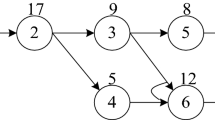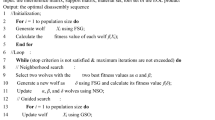Abstract
Disassembly is an important part of green manufacturing and remanufacturing. The disassembly line is an optimum form for mass and automatic disassembly in the industry. To optimize the disassembly system and the use of resources, the disassembly line balancing problem (DLBP) has attracted much attention. Compared with the conventional one-sided straight disassembly line, the two-sided disassembly line can use both the left and right sides of a conveyor belt for disassembly operation, thereby improving production efficiency, especially for large-sized and complicated products. On the other hand, due to the constraints and precedence among parts, it is a challenge to plan the disassembly scheme for a two-sided disassembly line. In this paper, a model is established to solve a two-sided disassembly line balancing problem (TDLBP). First, a hybrid graph is utilized to express constraints and precedence relationships, and a novel encoding and decoding method is developed for the disassembly scheme planning of a two-sided line for handling the challenge caused by constraints and precedence among parts. Then, a multi-objective TDLBP optimization model is proposed including the number of mated-workstations, idle time, smoothness index, the auxiliary indicator, and a meta-heuristic based on an artificial bee colony (ABC) algorithm is designed to solve TDLBP. Finally, the proposed model and method are applied to an automotive engine case, and the results are compared with NSGA-II, hybrid artificial bee colony algorithm (HABC), and multi-objective flower pollination algorithm (MOFPA) to verify the practicality of the proposed model in solving the TDLBP.















Similar content being viewed by others
References
Lee, C. M., Woo, W. S., & Roh, Y. H. (2017). Remanufacturing: Trends and Issues. International Journal of Precision Engineering and Manufacturing-Green Technology, 4(1), 113–125.
Kerin, M., & Pham, D. T. (2019). A review of emerging industry 4.0 technologies in remanufacturing. Journal of Cleaner Production, 237, 117805.
Kalayci, C. B., & Gupta, S. M. (2014). A tabu search algorithm for balancing a sequence-dependent disassembly line. Production Planning & Control, 25(2), 149–160.
Ozceylan, E., Kalayci, C. B., Gungor, A., & Gupta, S. M. (2019). Disassembly line balancing problem: A review of the state of the art and future directions. International Journal of Production Research, 57(15–16), 4805–4827.
Gupta, S., & Gungor, A. (1999). Disassembly Line Balancing. In Proceedings of the 1999 Annual Meeting of the Northeast Decision Sciences Institute, 193–195.
Battaia, O., & Dolgui, A. (2013). A taxonomy of line balancing problems and their solution approaches. International Journal of Production Economics, 142(2), 259–277.
Laili, Y., Li, Y., Fang, Y., Pham, D. T., & Zhang, L. (2020). Model review and algorithm comparison on multi-objective disassembly line balancing. Journal of Manufacturing Systems, 56, 484–500.
Tian, G., Zhou, M., & Li, P. (2018). Disassembly sequence planning considering fuzzy component quality and varying operational cost. IEEE Transactions on Automation Science and Engineering, 15(2), 748–760.
Ren, Y., Zhang, C., Zhao, F., Tian, G., Lin, W., Meng, L., et al. (2018). Disassembly line balancing problem using interdependent weights-based multi-criteria decision making and 2-Optimal algorithm. Journal of Cleaner Production, 174, 1475–1486.
Ilgin, M. A. (2019). A DEMATEL-based disassembly line balancing heuristic. Journal of Manufacturing Science and Engineering-Transactions of the Asme, 141(2), 021002.
Edis, E. B., Ilgin, M. A., & Edis, R. S. (2019). Disassembly line balancing with sequencing decisions: A mixed integer linear programming model and extensions. Journal of Cleaner Production, 238, 117826.
Mete, S., Cil, Z. A., Celik, E., & Ozceylan, E. (2019). Supply-driven rebalancing of disassembly lines: A novel mathematical model approach. Journal of Cleaner Production, 213, 1157–1164.
Kucukkoc, I. (2020). Balancing of two-sided disassembly lines: Problem definition, MILP model and genetic algorithm approach. Computers & Operations Research, 124, 105064.
McGovern, S. M., & Gupta, S. M. (2007). A balancing method and genetic algorithm for disassembly line balancing. European Journal of Operational Research, 179(3), 692–708.
Wang, S., Guo, X., & Liu, J. (2019). An efficient hybrid artificial bee colony algorithm for disassembly line balancing problem with sequence-dependent part removal times. Engineering Optimization, 51(11), 1920–1937.
Kalayci, C. B., & Gupta, S. M. (2013). A particle swarm optimization algorithm with neighborhood-based mutation for sequence-dependent disassembly line balancing problem. International Journal of Advanced Manufacturing Technology, 69(1–4), 197–209.
Kalayci, C. B., & Gupta, S. M. (2013). Ant colony optimization for sequence-dependent disassembly line balancing problem. Journal of Manufacturing Technology Management, 24(3), 413–427.
Cil, Z. A., Mete, S., & Serin, F. (2020). Robotic disassembly line balancing problem: A mathematical model and ant colony optimization approach. Applied Mathematical Modelling, 86, 335–348.
Pistolesi, F., Lazzerini, B., Mura, M. D., & Dini, G. (2018). EMOGA: A hybrid genetic algorithm with extremal optimization core for multiobjective disassembly line balancing. IEEE Transactions on Industrial Informatics, 14(3), 1089–1098.
Ren, Y., Yu, D., Zhang, C., Tian, G., Meng, L., & Zhou, X. (2017). An improved gravitational search algorithm for profit-oriented partial disassembly line balancing problem. International Journal of Production Research, 55(24), 7302–7316.
Liu, J., Zhou, Z., Pham, D. T., Xu, W., Ji, C., & Liu, Q. (2020). Collaborative optimization of robotic disassembly sequence planning and robotic disassembly line balancing problem using improved discrete Bees algorithm in remanufacturing. Robotics and Computer-Integrated Manufacturing, 61, 01829.
Yang, Y., Yuan, G., Zhuang, Q., & Tian, G. (2019). Multi-objective low-carbon disassembly line balancing for agricultural machinery using MDFOA and fuzzy AHP. Journal of Cleaner Production, 233, 1465–1474.
Wang, K., Li, X., Gao, L., & Li, P. (2020). Modeling and balancing for green disassembly line using associated parts precedence graph and multi-objective genetic simulated annealing. International Journal of Precision Engineering and Manufacturing-Green Technology. https://doi.org/10.1007/s40684-020-00259-7
Zhang, L., Zhao, X., Ke, Q., Dong, W., & Zhong, Y. (2021). Disassembly line balancing optimization method for high efficiency and low carbon emission. International Journal of Precision Engineering and Manufacturing-Green Technology, 8(1), 233–247.
Xia, X., Liu, W., Zhang, Z., Wang, L., Cao, J., & Liu, X. (2019). A balancing method of mixed-model disassembly line in random working environment. Sustainability, 11(8), 2304.
Yang, W., & Cheng, W. (2020). Modelling and solving mixed-model two-sided assembly line balancing problem with sequence-dependent setup time. International Journal of Production Research, 58(21), 6638–6659.
Karaboga, D., & Basturk, B. (2007). A powerful and efficient algorithm for numerical function optimization: Artificial bee colony (ABC) algorithm. Journal of Global Optimization, 39(3), 459–471.
Aslan, S., Badem, H., & Karaboga, D. (2019). Improved quick artificial bee colony (iqABC) algorithm for global optimization. Soft Computing, 23(24), 13161–13182.
Kalayci, C. B., & Gupta, S. M. (2013). Artificial bee colony algorithm for solving sequence-dependent disassembly line balancing problem. Expert Systems with Applications, 40(18), 7231–7241.
Wang, K., Li, X., & Gao, L. (2019). A multi-objective discrete flower pollination algorithm for stochastic two-sided partial disassembly line balancing problem. Computers & Industrial Engineering, 130, 634–649.
Zhang, X., Yu, G., Hu, Z., Pei, C., & Ma, G. (2014). Parallel disassembly sequence planning for complex products based on fuzzy-rough sets. International Journal of Advanced Manufacturing Technology, 72(1–4), 231–239.
Tian, G., Ren, Y., Feng, Y., Zhou, M., Zhang, H., & Tan, J. (2019). Modeling and planning for dual-objective selective disassembly using AND/OR graph and discrete artificial bee colony. IEEE Transactions on Industrial Informatics, 15(4), 2456–2468.
Wang, Y., Li, F., Li, J., Chen, J., Jiang, F., & Wang, W. (2009). Hybrid graph disassembly model and sequence planning for product maintenance. In International Technology and Innovation Conference 2006 (ITIC 2006), 515–519.
Zhang, Z., Wang, K., Zhu, L., & Wang, Y. (2017). A Pareto improved artificial fish swarm algorithm for solving a multi-objective fuzzy disassembly line balancing problem. Expert Systems with Applications, 86, 165–176.
Adibi, M. A., & Shahrabi, J. (2014). A clustering-based modified variable neighborhood search algorithm for a dynamic job shop scheduling problem. International Journal of Advanced Manufacturing Technology, 70(9–12), 1955–1961.
Wang, K., Li, X., & Gao, L. (2019). Modeling and optimization of multi-objective partial disassembly line balancing problem considering hazard and profit. Journal of Cleaner Production, 211, 115–133.
Deb, K., Pratap, A., Agarwal, S., & Meyarivan, T. (2002). A fast and elitist multiobjective genetic algorithm: NSGA-II. IEEE Transactions on Evolutionary Computation, 6(2), 182–197.
Bader, J., & Zitzler, E. (2011). HypE: An algorithm for fast hypervolume-based many-objective optimization. Evolutionary Computation, 19(1), 45–76.
Rostami, S., & Neri, F. (2017). A fast hypervolume driven selection mechanism for many-objective optimisation problems. Swarm and Evolutionary Computation, 34, 50–67.
Kalayci, C. B., Polat, O., & Gupta, S. M. (2016). A hybrid genetic algorithm for sequence-dependent disassembly line balancing problem. Annals of Operations Research, 242(2), 321–354.
Sitorus, F., Cilliers, J. J., & Brito-Parada, P. R. (2019). Multi-criteria decision making for the choice problem in mining and mineral processing: Applications and trends. Expert Systems with Applications, 121, 393–417.
Saaty, T. L. (1979). A scaling method for priorities in hierarchical structures. Journal of Mathematical Psychology, 15(3), 234–281.
Acknowledgements
This work is financially supported by the National Natural Science Foundation of China under Grant No.51875156 and the National Key R&D Program of China under Grant No.2018YFC1902304.
Funding
National Natural Science Foundation of China (No. 51875156), the National Key R&D Program of China (2018YFC1902304).
Author information
Authors and Affiliations
Corresponding author
Ethics declarations
Conflict of interest
The authors declare that they have no known competing financial interests or personal relationships that could have appeared to influence the work reported in this paper.
Additional information
Publisher's Note
Springer Nature remains neutral with regard to jurisdictional claims in published maps and institutional affiliations.
Rights and permissions
About this article
Cite this article
Zhang, L., Wu, Y., Zhao, X. et al. A Multi-objective Two-sided Disassembly Line Balancing Optimization Based on Artificial Bee Colony Algorithm: A Case Study of an Automotive Engine. Int. J. of Precis. Eng. and Manuf.-Green Tech. 9, 1329–1347 (2022). https://doi.org/10.1007/s40684-021-00394-9
Received:
Revised:
Accepted:
Published:
Issue Date:
DOI: https://doi.org/10.1007/s40684-021-00394-9




